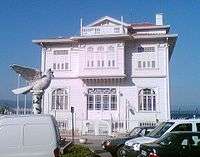Armistice of Mudanya
The Armistice of Mudanya (in Turkish: Mudanya Mütarekesi) was an agreement between Turkey (the Grand National Assembly of Turkey) on the one hand, and Italy, France and Britain on the other hand, signed in the Ottoman town of Mudanya, in the province of Bursa, on 11 October 1922. The Kingdom of Greece acceded to the armistice on 14 October 1922.
 | |
| Type | Armistice |
|---|---|
| Signed | 11 October 1922 |
| Location | Mudanya, Bursa, Turkey |
| Condition | Ratification |
| Signatories | |
| Languages | Turkish, English |
Context
Under the Armistice of Mudros, ending its part in World War I, the Allied powers were allowed to occupy the forts of the Straits of the Dardanelles and Bosphorus. Subsequently, they also occupied Constantinople. They also decided to partition the Ottoman Empire. This was resisted by Turkish nationalists in the form of the Grand National Assembly. Having achieved victories over occupying powers in Anatolia, Turkish forces were advancing on the neutral zone of the Straits.
On 5 September 1922, Mustafa Kemal Atatürk asserted the Turkish claim to East Thrace. On 15 September, the British cabinet decided that British forces should maintain their position, and issued an ultimatum. On 19 September Britain decided to deny Constantinople and Thrace to the Turkish nationalists, but France, Yugoslavia, Italy, and the British Dominions objected to another war. Raymond Poincaré, the French prime minister, persuaded the Turks to respect the neutral zone. The allies asked for a peace conference on 23 September, to which Mustafa Kemal agreed on 29 September, nominating Mudanya as the venue.[1] At the same time, the British cabinet decided to abandon East Thrace to the Turks.[2]
Talks were convened on 3 October, leading to the Armistice of Mudanya being signed on 11 October, agreement being reached two hours before British troops were due to attack at Çanakkale. The Greeks acceded to the terms on 13 October.[1]
Factors that convinced the Turks to sign probably included the arrival of British reinforcements.[3]
Terms of the Armistice
Under the terms agreed:
- Greek troops were to leave Eastern Thrace as far as the Maritsa River (River Meriç) and Adrianople (Edirne) within 15 days.
- Civil power would become Turkish 30 days after the Greek troops left.
- No more than 8,000 Turkish gendarmes were to be in East Thrace until a peace treaty was completed.[4]
The final settlement between the parties was worked out at the Conference of Lausanne from 21 November 1922 to 24 February 1923 and from 23 April to 24 July 1923, leading to the Treaty of Lausanne.
Allied troops continued to occupy the neutral zone, until they were withdrawn under the terms of the treaty.[5]
Sources
- Harry J. Psomiades, The Eastern Question, the Last Phase: a study in Greek-Turkish diplomacy (Pella, New York 2000), 27-35.
- A.L. Macfie, 'The Chanak affair (September–October 1922)' Balkan Studies 20(2) (1979), 328.
- Macfie, 336.
- Psomiades, 33.
- See Occupation of Constantinople
- International Treaties of the Twentieth Century, London: Routledge, ISBN 0-415-14125-7.
- Atatürk by Andrew Mango (ISBN 0-7195-6592-8).